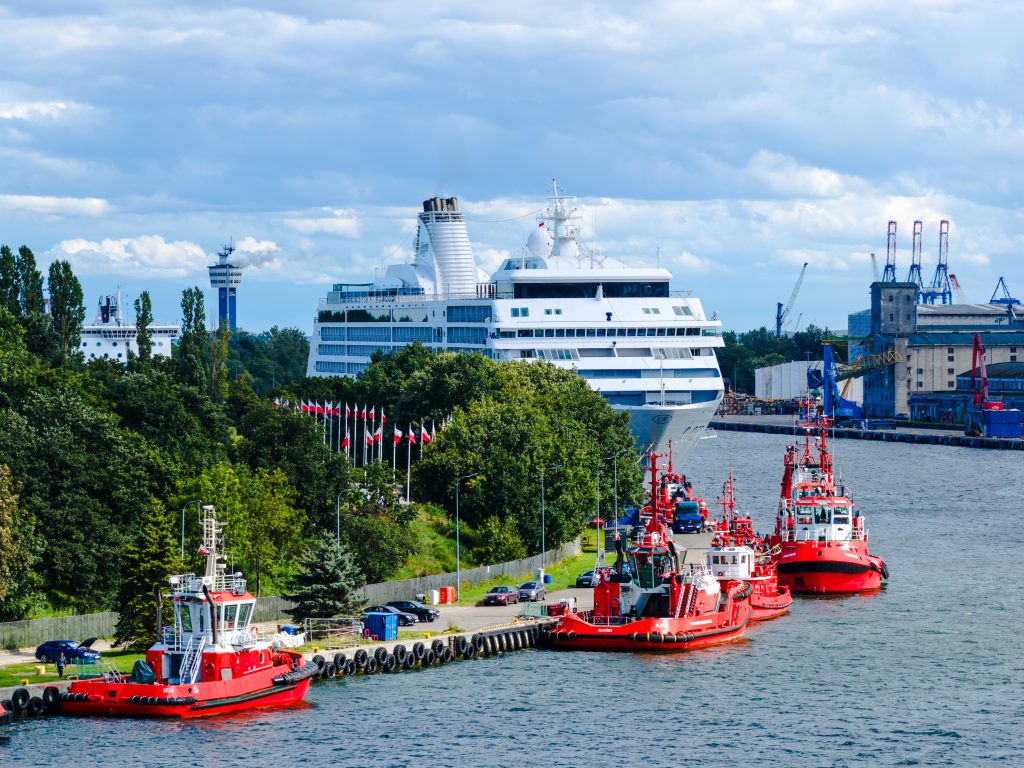Port of Gdańsk – stable traffic and increasingly larger cruise ships on the horizon

Cruise ship traffic in the Port of Gdańsk remains stable, at around 60 calls per year. Although there have been fluctuations over the years, the Port of Gdańsk remains one of the most important points on the Baltic cruise map. It soon has a chance to strengthen this position even further – thanks to the possibility of accommodating larger vessels. As many as 105 cruise ships have announced a visit to the Port of Gdańsk for 2027.
The record year in terms of the number of calls was 2022, when, after a downtime caused by the pandemic, cruise traffic was restored. At that time, as many as 79 ships with 29,500 passengers on board called at the Port of Gdańsk. It was an exceptional year, also due to the geopolitical situation – after the outbreak of war in Ukraine and the introduction of sanctions against Russia, passenger vessels avoided St. Petersburg, which until then had been the third most visited cruise port in the Baltic Sea. Some of the traffic was taken over by such ports as the Port of Gdańsk.
In the following years the situation has stabilised – in 2023 42 vessels called at the port, followed by 60 in 2024, with a similar result in 2025 – with 57 cruise ships visiting the Port of Gdańsk during this season. In total, over 27,000 tourists from several dozen countries arrived in Gdańsk. They were mainly Americans, Britons and Germans. Once ashore, they are most keen to visit the following landmarks: the Royal Route, Artus Court, St Mary’s Basilica, Oliwa Cathedral (organ concerts), Malbork Castle, European Solidarity Centre, Amber Museum and World War II Museum.
Increasingly larger vessels – the result of investment
Stable cruise traffic is the result of a well-thought-out promotional strategy, which includes the participation of representatives of the Port of Gdańsk in prestigious international trade fairs, such as Seatrade Cruise Global in Miami and Seatrade Cruise Europe in Hamburg. As a result, Gdańsk has become a well-known destination for tour operators planning cruises on the Baltic Sea.
‘Gdańsk has an enormous tourist and logistical potential. The Port of Gdańsk is located in the heart of the historic city, which means that passengers can visit one of the most beautiful places in Poland in just a few hours. This is a huge competitive advantage compared to many other ports in the region’, says Michał Stupak, Customer Manager in the Shipping Market Department at ZMPG SA.
But there are other advantages as well. Until recently, vessels up to 225-240 metres in length could call at the quays of the Port of Gdańsk. However, thanks to investments in infrastructure and dredging work in the Inner Port, today the port can welcome much larger ships – up to 250 metres in length and longer. In July the Crystal Serenity, a giant ship sailing under the Bahamian flag, moored at the Westerplatte Quay. It is one of the most luxurious cruise ships in the world. It is 250 metres long and belongs to the prestigious Crystal Cruises line, famous for its exclusive service, elegance and top-class travel. This vessel was built in 2003 and then underwent an upgrade 2 years ago. It has 347 cabins, two swimming pools, a modern fitness centre, a golf course, a full-size tennis court, a luxury shopping arcade, a casino, restaurants and bars.
The Viking Vella, a ship that is just slightly smaller at 239 metres long, has called at the Port of Gdańsk four times this season. And next year, the 299-metre-long cruise ship Rotterdam is due to arrive at the Port of Gdańsk. It is going to be the largest passenger ship in the history of the port, and its arrival will be a sign that the city on the Motława River has become a regular stop on the global passenger cruise routes.
Port of Gdańsk – an important spot on the Baltic Sea
However, the potential of the Port of Gdańsk is much greater than the current 60 calls per year. According to estimates, the port could handle up to 120 vessels per year, with proper scheduling and further infrastructure development.
‘Cruise ships usually stay in the Gdańsk Port for 8 to 12 hours, which allows passengers to thoroughly explore the city and its surroundings. There are also longer overnight visits – on average 2-3 times a year, when the cruise itinerary assumes an overnight stay in the port city. Such stays are particularly welcomed by local businesses and the tourism industry, as passenger ships and their passengers generate income mainly for the city’, said Michał Stupak.
Stable traffic, growing opportunities and investments in development mean that the Port of Gdańsk not only maintains but also strengthens its position among Baltic ports. This is proof of the consistent investment, development and adaptation of infrastructure to the requirements of global cruise operators.



